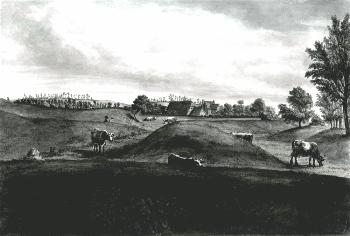
Site of Grove Priory about 1812 [Z315/3]
Grove Priory had its roots in a gift of £56 arising out of the Royal Manor of Leighton given by Henry I (1100-1135) in 1129 to the French Abbey of Fontevrault in Anjou. In 1164 his grandson Henry II (1154-1189) gave the whole of the manor to Fontevrault and it gradually came to be known as the Manor of Grove, later called the Manor of Leighton Alias Grovebury. The site lay in Bedfordshire and, despite the name, had no presence in the Buckinghamshire parish of Grove just across the River Ouzel. The site lay south of the modern A505 and Grovebury Farm in an area of sand quarrying.
At some time after 1164 Fontevrault established one of its six cells in England at Grovebury and this came to be called Grove Priory. The Priory and its associated manorial buildings were excavated from 1973 to 1985 by Bedfordshire County Council archaeology unit under Evelyn Baker and evidence of 6th and 7th century occupation was discovered but no evidence of continuous occupation through to the 12th century.
A windmill was built at Grove Priory and the hump in the picture at the top of the page shows the site of this in 1812. This hump is probably a prehistoric barrow and lays immediately west of the northern section of the lake at the sand quarry. In 1212 a dispute arose concerning this windmill between the prior and his tenants who alleged "that he has set it up and takes more toll there than he ought to take". This mill is also recorded in documents [like that of 1212, not at Bedfordshire & Luton Archives & Records Service] of 1224, 1242 and 1318. The prior was also in dispute about labour services from tenants in 1212, specifically about how much work they had to do on those manor lands the priory farmed itself rather than leasing to tenants. This contentious issue had arisen before, in 1194, and arose again at times until 1290.
Grove Priory only seems to have functioned as a priory in the 13th century (although there is an isolated mention of Richard de Greneburgh, Prior of Grove in 1333). Fontevrault Abbey was a double site, containing both monks and nuns under separate Abbot and Abbess. Grove, however, consisted solely of monks. The priory church seems to have been dedicated to Saint John as mentioned in a Roll of the Justices in Eyre in their visit to Bedford in 1227 when a groom fell from a cart and died and the price of the horse which caused the accident was given to the "Chapel of Saint John at Grove" [Bedfordshire Historical Records Society Volume III]. The men's chapel at Fontevrault was also dedicated to Saint John the Evangelist. The prior is usually simply called the Prior of Leighton from 1194 to 1240 or the Prior of Grove from 1242 to 1297. However, five priors are known by name:
- Vitalis;
- William;
- Nicholas;
- William de Verney;
- William de Lyencurt
The 20th century excavations reveal that Grove never became a fully blown priory with a monastic plan, but remained a farm with a chapel attached for worship and living quarters for the monks. The chapel was built, as one would expect in the mid 12th century, as was a timber hall, replaced by a stone hall in the late 12th or early 13th century. It was later extended north-west. About 1220 the Bishop of Lincoln granted a licence for a cemetery and an oratory.
Although Grove was not a priory during most of the 14th century the chapel was maintained as a chaplain is mentioned in the Bailiff's Accounts for the manor of 1341-1342 [translated in Bedfordshire Historical Records Society Volume 8 of 1924] and the Calendar of Patent Rolls in The National Archives records a grant of the manor to John Bele provided he found for two chaplains to daily celebrate mass at the manor for King Edward III and Queen Philippa. The same stipulation was made in 1373. The Clerical Subsidies Roll of 1390-1392 recorded two chaplains, John and Nicholas, at Grove. Thus the Priory seems to have existed only for about 150 years after which it reverted to a manor.